Chris Eboch's Blog, page 14
August 6, 2018
Writing Tight: Don't Be Wordy - #Writing Advice from Chris Eboch
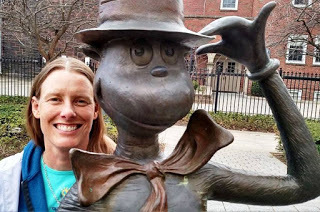 (From the "Most Viewed" files...)
(From the "Most Viewed" files...)I do a lot of manuscript critiques. (See my rates andrecommendations.) Even advanced writers often get wordy. Here are some tips on eliminating that problem so your writing is as tight as my current deadlines are (plus other sources with more detail).
One of my pet peeves is characters nodding their heads or shrugging their shoulders. What else would one nod or shrug? We don't nod our elbows or shrug our stomachs. (If you have a character doing that, then definitely specify!) Otherwise, you can simply say he noddedor she shrugged. Yes, I know, this is a tiny, unimportant detail. But trust me, once it's pointed out to you, you'll start to notice and find it irritating!
Another unnecessary phrase – he thought to himself. Unless you have psychic characters, we'll assume he's not thinking to someone else. (In close point of view, you don't need to use "he thought" at all; just state the thought and we'll understand that the character is thinking it. But that's another issue.)
If you have more web browsing time, here are a couple of my favorite posts on eliminating wordiness.
Cut the Clutter and Streamline Your Writing, from Crime Fiction Collective, by Jodie Renner Editing: “Once you’ve gotten through your first draft, it’s important to go back in and cut down on wordiness and redundancies in order to make your story more compelling, pick up the pace, and increase the tension and sense of urgency.”
Cut the Clutter and Streamline Your Writing, Part II, from Crime Fiction Collective by Jodie Renner Editing: “Start by cutting out qualifiers like very, quite, rather, somewhat, kind of, and sort of, which just dilute your message, weaken the imagery, and dissipate the tension.”
It’s a Story, Not an Instruction Manual!, from Crime Fiction Collective, by Jodie Renner Editing: “Whether you’re writing an action scene or a love scene, it’s best not to get too technical or clinical about which hand or leg or finger or foot is doing what, unless it’s relevant or necessary for understanding.”
And a warning not to take things too far:
Crossing Words Off Your List: Making the Most of Editing "What Not to Use" Lists, from The Other Side of the Story by Janice Hardy: “The right word for what you're trying to say is always the right choice, no matter what that word is. Most times, cutting that flabby word or finding that strong noun or active verb is the right choice, but once in a while it's not.”
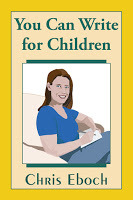 Chris Eboch is the author of over 50 books for children, including nonfiction and fiction, early reader through teen. Her novels for ages nine and up include The Eyes of Pharaoh, a mystery in ancient Egypt; The Well of Sacrifice, a Mayan adventure; The Genie’s Gift, a middle eastern fantasy; and the Haunted series, about kids who travel with a ghost hunter TV show, which starts with The Ghost on the Stairs. Her writing craft books include You Can Write for Children: How to Write Great Stories, Articles, and Books for Kids and Teenagers, and Advanced Plotting.
Chris Eboch is the author of over 50 books for children, including nonfiction and fiction, early reader through teen. Her novels for ages nine and up include The Eyes of Pharaoh, a mystery in ancient Egypt; The Well of Sacrifice, a Mayan adventure; The Genie’s Gift, a middle eastern fantasy; and the Haunted series, about kids who travel with a ghost hunter TV show, which starts with The Ghost on the Stairs. Her writing craft books include You Can Write for Children: How to Write Great Stories, Articles, and Books for Kids and Teenagers, and Advanced Plotting. Learn more at https://chriseboch.com/or her Amazon page, or check out her writing tips at her Write Like a Pro! blog.
Published on August 06, 2018 03:30
July 30, 2018
Story Plans: What's Your Characters Goal? #Writing Advice from Chris Eboch
 (From the "Most Viewed" files...)
(From the "Most Viewed" files...)My brother, script writer Doug Eboch (author of The Three Stages of Screenwriting and The Hollywood Pitching Bible ), had a blog post titled Not According to Plan. In it he states, “Over the last month I’ve read several scripts that suffered from lethargy and/or a feeling they were too episodic. The underlying cause was that the main characters were failing to make plans. They were reactive to events rather than driving the story. Giving the character plans keeps them active and gives the story forward momentum.”
In recent months, I’ve critiqued several manuscripts that were generally very strong. However, they suffered from the same problem. Here are couple of excerpts from the critiques (with some details hidden for privacy).
What’s lacking, I think, is clarity in MC’s Goals/Motivation and the Stakes.
Try to establish what MC wants up front, and keep reminding us of that or let us know how her goals change. For example, as she’s entering town, she may hope to find out more about her past. Once she knows about X, she wants to do Y. All of this ties into a longer, deep-seated goal of finding her place in the world. She may not be able to express that clearly, but we’ll see it in her short-term goals….
Her goals and motivations are also tied into the stakes. It’s important to have clear and high stakes – why her goals are important, and what happens if she fails. For example, if she fails to convince her mother to stay, she loses the chance to ever truly find a home with family who love and accept her.
She could even have both fears and hopes, sometimes seeing the positive and sometimes the negative. But showing us why this is so important to her will expand your theme and increase the stakes (what she has to gain or lose if she succeeds or fails).
And another:
One thing that may help you with your scenes is to think about scene goals. In every scene, your characters should have specific goals. These are likely immediate, short-term goals that lead to a larger story goal. For example, MC and MC2 want to get X, so they can do X. Focus on that goal, and the limited time they have, in each scene. If your main characters don’t have a goal – if they are just watching Comic Relief’s antics – it doesn’t move the story forward.
There’s an extra benefit to focusing on your character’s goals:
I think if you focus more on goals and stakes, you’ll also naturally develop your plot some. At times MC seems too passive, simply hoping things will or won’t happen and waiting for them. But if she has a strong, clear goal, you’ll see ways to increase the tension. (I went into more detail on this in my post on Happy Endings.)
And don’t forget –
We should also see MC actively pursuing her goals. If she doesn’t want to leave, she shouldn’t just silently hope for that. She should be trying to get what she wants.
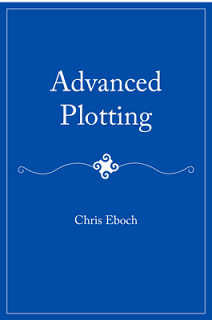 Advanced Plotting
helps writers
Advanced Plotting
helps writersfine-tune their plotFor more on cause/effect and clarifying goals, see the first couple of posts under the "pacing" label.
Here are more posts on conflict, goals and motivation:
Ask an Editor with Theresa Stevens: A first-page critique discussing goal, motivation, and conflict.
Channeling The Reader’s Brain: What We Expect of Every Story, by Lisa Cron on Janice Hardy’s blog: The protagonist should want something, fear something, struggle, and change.
Goal - Conflict - Stakes. Why You Need All Three, by Janice Hardy (you also might do a search on “goals” on Janice Hardy’s blog, as she has a lot on the subject).
The Two Things Every Novel Needs—Conflict and Suspense, by James Scott Bell on Crime Fiction Collective. Worrying Isn’t Action by Mary Kole from Kidlit.com.
And please do see my brother’s full blog post, Not According to Plan.
So, what’s your goal now?
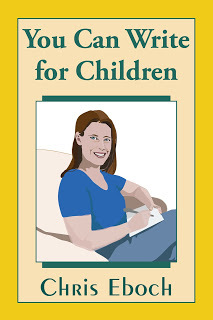 Chris Eboch is the author of over 50 books for children, including nonfiction and fiction, early reader through teen. Her novels for ages nine and up include The Eyes of Pharaoh, a mystery in ancient Egypt; The Well of Sacrifice, a Mayan adventure; The Genie’s Gift, a middle eastern fantasy; and the Haunted series, about kids who travel with a ghost hunter TV show, which starts with The Ghost on the Stairs. Her writing craft books include You Can Write for Children: How to Write Great Stories, Articles, and Books for Kids and Teenagers, and Advanced Plotting.
Chris Eboch is the author of over 50 books for children, including nonfiction and fiction, early reader through teen. Her novels for ages nine and up include The Eyes of Pharaoh, a mystery in ancient Egypt; The Well of Sacrifice, a Mayan adventure; The Genie’s Gift, a middle eastern fantasy; and the Haunted series, about kids who travel with a ghost hunter TV show, which starts with The Ghost on the Stairs. Her writing craft books include You Can Write for Children: How to Write Great Stories, Articles, and Books for Kids and Teenagers, and Advanced Plotting. Learn more at https://chriseboch.com/or her Amazon page.
Published on July 30, 2018 03:00
March 3, 2018
Advanced Plotting Techniques Handout
Fast Start Options:Start in the action, at a moment of change. Then work in the back story if needed.Start with two people on the page.Start with a scene, with action and dialogue. Use description and summary modestly, and only if really needed.Start in the middle of a fight or other conflict.Start with a cliffhanger – something powerful about to happen.The inciting incident – the problem that gets the story going – should happen as soon as possible, but not until the moment is ripe. The reader must have enough understanding of the character and situation to make the incident meaningful. Too soon, and the reader is confused. Too late, and the reader gets bored first.Try starting with a small problem that leads to the big problem, or is an example of the main problem.See also “Beginnings” Label in the right-hand column.
Plot Tricks:· Use the rule of three – the main character should try and fail at least twice before solving the problem on the third try. In long works, use this for each challenge.· Increase the complications – at each step, more is at stake, there’s greater risk. If each scene has the same level of risk and consequence, the pacing is flat and the middle sags. · Up the ante – offer a better reward or more serious consequences.· A time deadline increases tension.· Give it a twist – new information that changes everything but still makes sense (Darth Vader is Luke’s father).· If you get stuck on “What happens next?” try looking from the antagonist’s POV. What are they doing to stop your character? Other characters can also add complications.· Keep your chapters short, and make sure every one has dramatic action. · Use the Plot Outline Exercise from Advanced Plotting · More important and dramatic events should be written out in detail, others can be summarized. · Use shorter words and sentences to speed the pace.· See also “Plotting” Label right-hand column.
Story Analysis Resources:Self-Editing for Fiction Writers, by Renni Browne and Dave KingScene & Structure, Jack M. BickhamWriting the Blockbuster Novel, by Albert Zuckerman Advanced Plotting : a tool for analyzing your plot, articles on fast starts, developing middles, plot points, cliffhangers, and more advice on making your work stronger. The Plot Arc Exercise as a free Word downloadChris’s Write Like a Pro! blog has writing craft tips. Visit Blockbuster Plots for Writers for a test that shows whether your writing is more character driven or plot driven.Story analysis at Doug Eboch’s blog on Screenwriting Strong starts, by Keith CroninWays to look at plot arc by Jan Fields: a mountain or a pit?Plot Maps by Lee Wardlaw, Project MayhemExample of plot mapping via Caroline Starr RoseThe Blake Snyder Beat Sheet Links to cool plot tools via Molly BlaisdellJanet Fox’s Diagram of Plot Points for different systemsDianne K. Salerni shares her plotting technique Beyond Story Mountains & Arcs: The Many Shapes of Stories, by Vicki Vinton shows how to analyze the stories of others.QueryTracker:How to Plot (or Revise) Your BookAnnie Neugebauer's Novel Plotting WorksheetJenny Meyerhoff's Plotting Worksheet Chris Eboch’s book Advanced Plotting helps writers fine-tune their plots. Advanced Plotting is designed for the intermediate and advanced writer. If you struggle with plot or suspect your plotting needs work, this book can help. Use the Plot Outline Exercise to identify and fix plot weaknesses. Learn how to get off to a fast start, prop up a sagging middle, build to a climax, improve your pacing, and more.
Chris Eboch’s book Advanced Plotting helps writers fine-tune their plots. Advanced Plotting is designed for the intermediate and advanced writer. If you struggle with plot or suspect your plotting needs work, this book can help. Use the Plot Outline Exercise to identify and fix plot weaknesses. Learn how to get off to a fast start, prop up a sagging middle, build to a climax, improve your pacing, and more.
Get Advanced Plotting from Amazon
 Chris offers novel critiques for $2 per page ($100 minimum). Contact Chris for details and recommendations.
Chris offers novel critiques for $2 per page ($100 minimum). Contact Chris for details and recommendations.
You Can Write for Children : How to Write Great Stories, Articles, and Books for Kids and Teenagers offers an overview on writing for young people. Learn how to find ideas and develop those ideas into stories, articles, and books. Understand the basics of character development, plot, setting, and theme – and some advanced elements, along with how to use point of view, dialogue, and thoughts. Finally, learn about editing your work and getting critiques.
You Can Write for Children : How to Write Great Stories, Articles, and Books for Kids and Teenagers is available for the Kindle, in paperback, or in Large Print paperback.
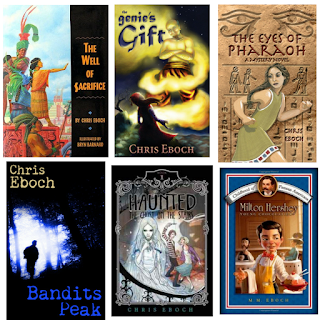 Chris Eboch is the author of over 50 books for children, including nonfiction and fiction, early reader through teen. Her novels for ages nine and up include The Eyes of Pharaoh, a mystery in ancient Egypt; The Well of Sacrifice, a Mayan adventure; The Genie’s Gift, a middle eastern fantasy; and the Haunted series, about kids who travel with a ghost hunter TV show, which starts with The Ghost on the Stairs.
Chris Eboch is the author of over 50 books for children, including nonfiction and fiction, early reader through teen. Her novels for ages nine and up include The Eyes of Pharaoh, a mystery in ancient Egypt; The Well of Sacrifice, a Mayan adventure; The Genie’s Gift, a middle eastern fantasy; and the Haunted series, about kids who travel with a ghost hunter TV show, which starts with The Ghost on the Stairs.
Learn more at https://chriseboch.com/ or her Amazon page.
 Chris also writes for adults under the name Kris Bock. Kris Bock writes action-packed romantic suspense involving outdoor adventures and Southwestern landscapes. The Mad Monk’s Treasure follows a treasure hunt in New Mexico and has been called “Smart romance with an Indiana Jones feel.”
Chris also writes for adults under the name Kris Bock. Kris Bock writes action-packed romantic suspense involving outdoor adventures and Southwestern landscapes. The Mad Monk’s Treasure follows a treasure hunt in New Mexico and has been called “Smart romance with an Indiana Jones feel.”
Counterfeitsstarts a new series about art theft. What We Found is a mystery with romantic elements about a young woman who finds a murder victim in the woods. Whispers in the Dark involves intrigue among ancient Southwest ruins. Read excerpts at www.krisbock.com or visit her Amazon page. All books are free with Kindle Unlimited.
Plot Tricks:· Use the rule of three – the main character should try and fail at least twice before solving the problem on the third try. In long works, use this for each challenge.· Increase the complications – at each step, more is at stake, there’s greater risk. If each scene has the same level of risk and consequence, the pacing is flat and the middle sags. · Up the ante – offer a better reward or more serious consequences.· A time deadline increases tension.· Give it a twist – new information that changes everything but still makes sense (Darth Vader is Luke’s father).· If you get stuck on “What happens next?” try looking from the antagonist’s POV. What are they doing to stop your character? Other characters can also add complications.· Keep your chapters short, and make sure every one has dramatic action. · Use the Plot Outline Exercise from Advanced Plotting · More important and dramatic events should be written out in detail, others can be summarized. · Use shorter words and sentences to speed the pace.· See also “Plotting” Label right-hand column.
Story Analysis Resources:Self-Editing for Fiction Writers, by Renni Browne and Dave KingScene & Structure, Jack M. BickhamWriting the Blockbuster Novel, by Albert Zuckerman Advanced Plotting : a tool for analyzing your plot, articles on fast starts, developing middles, plot points, cliffhangers, and more advice on making your work stronger. The Plot Arc Exercise as a free Word downloadChris’s Write Like a Pro! blog has writing craft tips. Visit Blockbuster Plots for Writers for a test that shows whether your writing is more character driven or plot driven.Story analysis at Doug Eboch’s blog on Screenwriting Strong starts, by Keith CroninWays to look at plot arc by Jan Fields: a mountain or a pit?Plot Maps by Lee Wardlaw, Project MayhemExample of plot mapping via Caroline Starr RoseThe Blake Snyder Beat Sheet Links to cool plot tools via Molly BlaisdellJanet Fox’s Diagram of Plot Points for different systemsDianne K. Salerni shares her plotting technique Beyond Story Mountains & Arcs: The Many Shapes of Stories, by Vicki Vinton shows how to analyze the stories of others.QueryTracker:How to Plot (or Revise) Your BookAnnie Neugebauer's Novel Plotting WorksheetJenny Meyerhoff's Plotting Worksheet
 Chris Eboch’s book Advanced Plotting helps writers fine-tune their plots. Advanced Plotting is designed for the intermediate and advanced writer. If you struggle with plot or suspect your plotting needs work, this book can help. Use the Plot Outline Exercise to identify and fix plot weaknesses. Learn how to get off to a fast start, prop up a sagging middle, build to a climax, improve your pacing, and more.
Chris Eboch’s book Advanced Plotting helps writers fine-tune their plots. Advanced Plotting is designed for the intermediate and advanced writer. If you struggle with plot or suspect your plotting needs work, this book can help. Use the Plot Outline Exercise to identify and fix plot weaknesses. Learn how to get off to a fast start, prop up a sagging middle, build to a climax, improve your pacing, and more. Get Advanced Plotting from Amazon
 Chris offers novel critiques for $2 per page ($100 minimum). Contact Chris for details and recommendations.
Chris offers novel critiques for $2 per page ($100 minimum). Contact Chris for details and recommendations.You Can Write for Children : How to Write Great Stories, Articles, and Books for Kids and Teenagers offers an overview on writing for young people. Learn how to find ideas and develop those ideas into stories, articles, and books. Understand the basics of character development, plot, setting, and theme – and some advanced elements, along with how to use point of view, dialogue, and thoughts. Finally, learn about editing your work and getting critiques.
You Can Write for Children : How to Write Great Stories, Articles, and Books for Kids and Teenagers is available for the Kindle, in paperback, or in Large Print paperback.
 Chris Eboch is the author of over 50 books for children, including nonfiction and fiction, early reader through teen. Her novels for ages nine and up include The Eyes of Pharaoh, a mystery in ancient Egypt; The Well of Sacrifice, a Mayan adventure; The Genie’s Gift, a middle eastern fantasy; and the Haunted series, about kids who travel with a ghost hunter TV show, which starts with The Ghost on the Stairs.
Chris Eboch is the author of over 50 books for children, including nonfiction and fiction, early reader through teen. Her novels for ages nine and up include The Eyes of Pharaoh, a mystery in ancient Egypt; The Well of Sacrifice, a Mayan adventure; The Genie’s Gift, a middle eastern fantasy; and the Haunted series, about kids who travel with a ghost hunter TV show, which starts with The Ghost on the Stairs. Learn more at https://chriseboch.com/ or her Amazon page.
 Chris also writes for adults under the name Kris Bock. Kris Bock writes action-packed romantic suspense involving outdoor adventures and Southwestern landscapes. The Mad Monk’s Treasure follows a treasure hunt in New Mexico and has been called “Smart romance with an Indiana Jones feel.”
Chris also writes for adults under the name Kris Bock. Kris Bock writes action-packed romantic suspense involving outdoor adventures and Southwestern landscapes. The Mad Monk’s Treasure follows a treasure hunt in New Mexico and has been called “Smart romance with an Indiana Jones feel.”
Counterfeitsstarts a new series about art theft. What We Found is a mystery with romantic elements about a young woman who finds a murder victim in the woods. Whispers in the Dark involves intrigue among ancient Southwest ruins. Read excerpts at www.krisbock.com or visit her Amazon page. All books are free with Kindle Unlimited.
Published on March 03, 2018 03:00
November 22, 2017
Get Ready for a Happy #Holiday With a #99c #Romance from @Kris_Bock
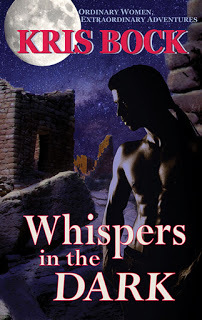 While normally I post about the craft of writing on this blog, I want to share news about a sale on one of my romantic suspense novels for adults.
While normally I post about the craft of writing on this blog, I want to share news about a sale on one of my romantic suspense novels for adults.Whispers in the Dark, by Kris Bock
Archaeology student Kylie Hafford expects an adventure when she heads to remote Puebloan ruins to excavate. Romance isn’t part of her plan, but she meets two sexy men: Sean is a charming tourist who takes an instant liking to Kylie. Danesh, a site ranger who looks like an Anasazi warrior, seems to take an instant dislike to Kylie, and yet something draws them together. The summer heats up as Kylie uncovers mysteries, secrets, and terrors in the dark. She’ll need all her strength and wits to survive – and to save the man she’s coming to love.
Readers give a 4.2-star average to Whispers in the Dark, romantic suspense set in the Four Corners region of the Southwest. It stands alone and is not part of a series. Fans of Mary Stewart, Barbara Michaels, and Victoria Holt will love Kris Bock’s stories of romance and adventure.
Whispers in the Dark is on sale Nov. 19-24 – only 99 cents for the Kindle! Get it now!
Excerpt:
I hit something, bounced, scraped, and finally landed with a thud that rattled my whole body.
I lay in the dark, blinded, my head ringing, pain washing over me in great waves. My lungs screamed for air, but it seemed like I’d forgotten how to breathe.
Finally I dragged in a breath. I closed my eyes and focused on breathing, waiting for the world to settle into place.
Rain misted my face, so I must be lying on my back. My head felt heavier than my feet. I shifted and realized I was lying on a slope with my head pointing down.
I tried to concentrate on those little details. I couldn’t handle anything more. Panic fluttered around me, but I refused to think about anything but the present moment. I flexed my fingers. When that worked, I moved my hands over my body, up to my face. My head throbbed, but when I felt around my skull, I didn’t find any serious damage.
I had to move. The thought battered at the back of my mind, a panicky whisper that I tried to ignore. I had to run. Hide. He was after me. I had to get away.
I clenched my teeth hard, as if I could bite back the pain and fear. Memories crowded in, like panicked ghosts wailing at the edges of my mind. Guns, strange men. Dangerous, threatening men. Danesh trying to protect me, the gun going off. My own helpless, panicked flight. Helpless. Worthless. Unable to fight, unable even to scream.
I tried to focus on this one moment, the physical sensations of my aching body as I lay on the hard, damp ground. The cold against my bare calves, the lump of rock pressing into my shoulder. That focus helped keep me grounded in the present. Never mind that this present wasn’t a place I wanted to be. I had to deal with reality. But I didn’t have to also deal with nightmares. Not now.
The little whimpers in my throat faded to short gasping breaths. I held on to this moment, this single slice of reality. Now to move forward. I didn’t have to like it, but I had to do it. One step at a time.
Get Whispers in the Dark on sale for 99 cents for the Kindle!
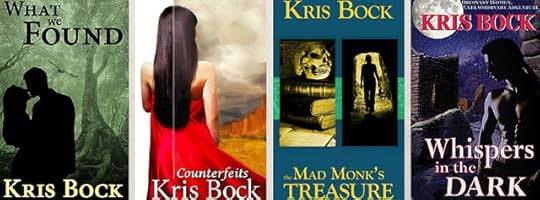 Kris Bock writes novels of suspense and romance involving outdoor adventures and Southwestern landscapes. In Counterfeits, stolen Rembrandt paintings bring danger to a small New Mexico town. What We Found is a romantic mystery about a young woman who finds a murder victim in the woods. The Mad Monk’s Treasure follows the hunt for a long-lost treasure in the New Mexico desert. In The Dead Man’s Treasure, estranged relatives compete to reach a buried treasure by following a series of complex clues. Read excerpts at www.krisbock.com or visit her Amazon page. You can also follow her blog, The Southwest Armchair Traveler.
Kris Bock writes novels of suspense and romance involving outdoor adventures and Southwestern landscapes. In Counterfeits, stolen Rembrandt paintings bring danger to a small New Mexico town. What We Found is a romantic mystery about a young woman who finds a murder victim in the woods. The Mad Monk’s Treasure follows the hunt for a long-lost treasure in the New Mexico desert. In The Dead Man’s Treasure, estranged relatives compete to reach a buried treasure by following a series of complex clues. Read excerpts at www.krisbock.com or visit her Amazon page. You can also follow her blog, The Southwest Armchair Traveler.
Published on November 22, 2017 04:00
October 14, 2017
My #KidLit #PoweredByIndie Story + Self-Publishing Advice
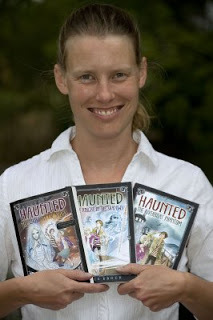 I’m not exactly an outsider to traditional publishing. I’ve had 50 children’s books traditionally published, some work for hire and some original fiction, with 10 more currently under contract. But several years ago, negative trends in traditional publishing (lower advances, poor e-book royalty rates, reduced marketing) met the increased ease of self-publishing through ebooks and print on demand. I weighed the pros and cons (there are many of each) and decided to explore self-publishing myself.
I’m not exactly an outsider to traditional publishing. I’ve had 50 children’s books traditionally published, some work for hire and some original fiction, with 10 more currently under contract. But several years ago, negative trends in traditional publishing (lower advances, poor e-book royalty rates, reduced marketing) met the increased ease of self-publishing through ebooks and print on demand. I weighed the pros and cons (there are many of each) and decided to explore self-publishing myself. For the Children
Most of the indie publishing success stories involve those writing adult genre fiction. Young adult novels – aimed at teenagers with crossover potential for adult readership – have had indie success (e.g. Amanda Hocking). However, authors writing for younger children face more challenges.
Print is still king for kids, and print is more expensive to produce. Younger kids are less likely to have their own e-readers, though that is changing quickly. Some schools are also transitioning toward giving upper elementary and middle school children laptops or e-readers for classroom use. (As a curious side effect, some kids prefer print books for pleasure reading, because electronic devices now seem like part of school.)
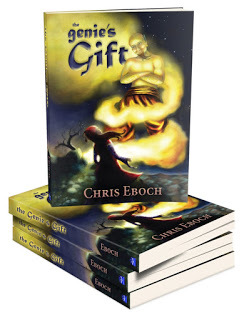 As more children get access to e-readers, electronic book sales will grow. However, so far, my children’s books sales are primarily in print on demand. The balance may shift someday – but I haven’t seen any sign of it yet. You could hold onto your work, waiting for that future, but keeping your rights has to be balanced against starting to build a fan base now through traditional publishing (and maybe getting some advance money so you can afford the time to write more books).
As more children get access to e-readers, electronic book sales will grow. However, so far, my children’s books sales are primarily in print on demand. The balance may shift someday – but I haven’t seen any sign of it yet. You could hold onto your work, waiting for that future, but keeping your rights has to be balanced against starting to build a fan base now through traditional publishing (and maybe getting some advance money so you can afford the time to write more books).
Reaching Young Readers
Reaching child readers is another challenge. Children’s book publishing depends largely on school and library sales. Librarians and teachers often turn to review journals for guidance, and schools are restricted in how they can order classroom books. A good contract with a traditional publisher that can get your book into schools and libraries definitely has its advantages.
Illustrated books face additional challenges. Print on demand costs skyrocket for books with color interior illustrations. Even with novels, children’s books are more likely to need illustrated covers rather than cheaper covers using stock photography.
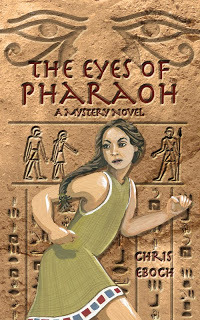 Despite the challenges, many children’s book writers are interested in indie publishing. After all, it’s better to be ahead of the wave than behind it. And at least writers whose work isn’t trendy or who get dumped by their publishers have another option now.
Despite the challenges, many children’s book writers are interested in indie publishing. After all, it’s better to be ahead of the wave than behind it. And at least writers whose work isn’t trendy or who get dumped by their publishers have another option now.In particular, indie publishing provides opportunities for books that may not otherwise find an audience. I had a middle grade (ages 9 to 12) mystery set in ancient Egypt. The story had gotten great feedback from publishers, along with either “Historical fiction isn’t selling well” or “We already have an Egypt book.” And yet several teachers told me they wished I’d get the book published, so they could use it in the classroom. I sensed a market that publishers weren’t recognizing, and I had a manuscript I loved. Thus, I brought out The Eyes of Pharaoh in POD and e-book versions.
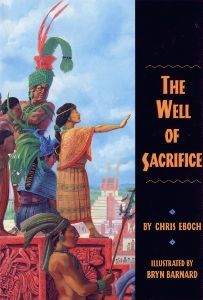 My first traditionally published novel, an adventure set in ninth-century Mayan Guatemala called
The Well of Sacrifice
, is used in many schools when they teach the Maya in fourth grade. I’ve had contact with some of those teachers, so I let them know about the new book. One e-mailed back that she’d ordered six copies for her lit circles. If teachers find that The Eyes of Pharaoh works well in the classroom, they’ll tell others, so this book could gain popularity slowly, by word of mouth.
My first traditionally published novel, an adventure set in ninth-century Mayan Guatemala called
The Well of Sacrifice
, is used in many schools when they teach the Maya in fourth grade. I’ve had contact with some of those teachers, so I let them know about the new book. One e-mailed back that she’d ordered six copies for her lit circles. If teachers find that The Eyes of Pharaoh works well in the classroom, they’ll tell others, so this book could gain popularity slowly, by word of mouth. Plus, many kids love ancient Egypt. If they go looking for books on the subject, they might find mine. There are a few other Egypt novels out there, but the niche isn’t as crowded as, say, fantasy novels. If you have something unusual that appeals to a small market segment (perhaps too small to attract a big publisher), self-publishing is a valuable option.
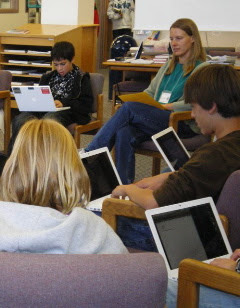 Self-publishing isn’t for everyone, but it can be a great option for those who like to control every aspect of their business. More than anything, I’ve enjoyed feeling like I have control of my career again. No waiting six months or more to hear back from an editor, or years to see a book in print. No suffering from the whims of the marketing department or falling victim to power plays at the publisher. No one to blame for setbacks but myself!
Self-publishing isn’t for everyone, but it can be a great option for those who like to control every aspect of their business. More than anything, I’ve enjoyed feeling like I have control of my career again. No waiting six months or more to hear back from an editor, or years to see a book in print. No suffering from the whims of the marketing department or falling victim to power plays at the publisher. No one to blame for setbacks but myself! If you’re looking for quick fame and riches, you might as well play the lottery – it’s probably cheaper and your chance of success is nearly as good. But if you’re willing to work hard and plan for the future, self-publishing could be part of your business. Plus, if you have a book that doesn’t fit market trends, but may still find an enthusiastic (even if small) audience, you can bring the book out yourself. Knowing your work is being read – and dare I say loved? – is the best reward.
Stop by my blog post on the “Indie Publishing Worksheet” with questions to help you decide whether or not self-publishing is right for you, and if so, what steps to take.
 Chris Eboch is the author of nonfiction and fiction for children, early reader through teen. Her novels for ages nine and up include The Eyes of Pharaoh, a mystery in ancient Egypt; The Well of Sacrifice, a Mayan adventure; The Genie’s Gift, a middle eastern fantasy; and the Haunted series, about kids who travel with a ghost hunter TV show, which starts with The Ghost on the Stairs. Her writing craft books include You Can Write for Children: How to Write Great Stories, Articles, and Books for Kids and Teenagers, and Advanced Plotting.
Chris Eboch is the author of nonfiction and fiction for children, early reader through teen. Her novels for ages nine and up include The Eyes of Pharaoh, a mystery in ancient Egypt; The Well of Sacrifice, a Mayan adventure; The Genie’s Gift, a middle eastern fantasy; and the Haunted series, about kids who travel with a ghost hunter TV show, which starts with The Ghost on the Stairs. Her writing craft books include You Can Write for Children: How to Write Great Stories, Articles, and Books for Kids and Teenagers, and Advanced Plotting.Learn more at https://chriseboch.com/or her Amazon page.
 Chris also writes for adults under the name Kris Bock. Kris Bock writes action-packed romantic suspense involving outdoor adventures amidst Southwestern landscapes. The Mad Monk’s Treasure follows a treasure hunt in New Mexico. Whispers in the Dark involves intrigue among ancient Southwest ruins. Counterfeitsstarts a series about art theft. What We Found is a mystery with romantic elements about a young woman who finds a murder victim in the woods. Read excerpts at www.krisbock.comor visit her Amazon page.
Chris also writes for adults under the name Kris Bock. Kris Bock writes action-packed romantic suspense involving outdoor adventures amidst Southwestern landscapes. The Mad Monk’s Treasure follows a treasure hunt in New Mexico. Whispers in the Dark involves intrigue among ancient Southwest ruins. Counterfeitsstarts a series about art theft. What We Found is a mystery with romantic elements about a young woman who finds a murder victim in the woods. Read excerpts at www.krisbock.comor visit her Amazon page.
Published on October 14, 2017 04:00
October 9, 2017
Self-Publishing Worksheet #PoweredByIndie
Should you self publish? Are you ready to start? This questionnaire will give you an overview on what you need. (Please note that the indie publishing world changes quickly and this is not frequently updated.)
What is your primary purpose for self-publishing? (Earning money, sharing the book with family/friends, sharing a message, breaking into publishing, attracting an agent, etc.)
What are your secondary purposes?
How much time can/will you devote?
What resources do you have?
How much money to invest?
Proofreading skills?
Layout skills (for POD)? Computer processing/HTML skills (for e-book layout)?
Cover art/design skills?
Interior art, photography, or special formatting (tables, maps) if needed?
Publicity/social networking skills/platform?
Business experience: accounting, tax, running a small business, etc.?
Who is your audience?
What do you see as your primary sales channel? E-books, print orders from Amazon (print on demand), or direct-sales via author events or your website (in which case consider using a printer for the best price on bulk orders)? (If your answer is bookstores or libraries, focus on traditional publishing.)
How much will your book cost? For POD, calculate price based on size and page count. Will your audience pay that much? How many copies will you have to sell to make back your investment? To meet other goals?
Are you confident that your manuscript is ready for publication? Why or why not?
What steps do you need to take to prepare for self-publishing? Estimate the cost in time and money.
Professional editorial feedback.
Further editing on your own.
Proofreading.
Table of contents, index, appendices? Interior art, photography, or special formatting (tables, maps, interior links for e-books)? Include any time/cost for acquiring rights to quotes or images.Interior layout for print on demand.
File conversion for e-book.
Cover art/design. Will you need illustration or photography? Front cover only (e-book), or spine and back (POD)?
Getting an ISBN. (Free to $125 for a single number, free to $250 for 10. Different numbers needed for each version, e.g. paperback, hardcover, and e-book.)
Uploading your material for e-book or print on demand, or contracting with a printer.
Publicity/marketing. Options include: hiring a publicity firm, sending press releases, e-mailing friends and family, building a webpage, blogging, setting up a blog tour or guest blog posts, developing press kits, sending your work to reviewers or paying for reviews, creating an Amazon Listmania list, and participating in social networking sites such as Facebook, Twitter, Amazon’s Author Central, GoodReads, Library Thing, Shelfari, Jacket Flap, and the Kindle Boards. Social networking in particular is an ongoing time expense—how many hours per week can you devote to it?For children’s books, a teaching guide or lesson plans can be a good marketing tool. These typically cost $200 and up.
Additional Resources/Books on Self-Publishing:* Intent to Sell: Marketing the Genre Novel by Jeffrey A. Marks Quit Your Day Job, A Guide for the Self Published Author * Smart Self-Publishing: Becoming an Indie Author by Zoe Winters
* Let’s Get Digital: How To Self-Publish, And Why You Should by David Gaughran
* We Are Not Alone: The Writer’s Guide to Social Media by Kristen Lamb
* Write It Forward: From Writer to Successful Author Bob Mayer
* Dollars & Sense: The Definitive Guide to Self-publishing Success by Carolyn McCray, Amber & Rachel Thompson* Anyone Can Make a Kindle Book, by Peter Spenser (easy formatting information): reviewed
What is your primary purpose for self-publishing? (Earning money, sharing the book with family/friends, sharing a message, breaking into publishing, attracting an agent, etc.)
What are your secondary purposes?
How much time can/will you devote?
What resources do you have?
How much money to invest?
Proofreading skills?
Layout skills (for POD)? Computer processing/HTML skills (for e-book layout)?
Cover art/design skills?
Interior art, photography, or special formatting (tables, maps) if needed?
Publicity/social networking skills/platform?
Business experience: accounting, tax, running a small business, etc.?
Who is your audience?
What do you see as your primary sales channel? E-books, print orders from Amazon (print on demand), or direct-sales via author events or your website (in which case consider using a printer for the best price on bulk orders)? (If your answer is bookstores or libraries, focus on traditional publishing.)
How much will your book cost? For POD, calculate price based on size and page count. Will your audience pay that much? How many copies will you have to sell to make back your investment? To meet other goals?
Are you confident that your manuscript is ready for publication? Why or why not?
What steps do you need to take to prepare for self-publishing? Estimate the cost in time and money.
Professional editorial feedback.
Further editing on your own.
Proofreading.
Table of contents, index, appendices? Interior art, photography, or special formatting (tables, maps, interior links for e-books)? Include any time/cost for acquiring rights to quotes or images.Interior layout for print on demand.
File conversion for e-book.
Cover art/design. Will you need illustration or photography? Front cover only (e-book), or spine and back (POD)?
Getting an ISBN. (Free to $125 for a single number, free to $250 for 10. Different numbers needed for each version, e.g. paperback, hardcover, and e-book.)
Uploading your material for e-book or print on demand, or contracting with a printer.
Publicity/marketing. Options include: hiring a publicity firm, sending press releases, e-mailing friends and family, building a webpage, blogging, setting up a blog tour or guest blog posts, developing press kits, sending your work to reviewers or paying for reviews, creating an Amazon Listmania list, and participating in social networking sites such as Facebook, Twitter, Amazon’s Author Central, GoodReads, Library Thing, Shelfari, Jacket Flap, and the Kindle Boards. Social networking in particular is an ongoing time expense—how many hours per week can you devote to it?For children’s books, a teaching guide or lesson plans can be a good marketing tool. These typically cost $200 and up.
Additional Resources/Books on Self-Publishing:* Intent to Sell: Marketing the Genre Novel by Jeffrey A. Marks Quit Your Day Job, A Guide for the Self Published Author * Smart Self-Publishing: Becoming an Indie Author by Zoe Winters
* Let’s Get Digital: How To Self-Publish, And Why You Should by David Gaughran
* We Are Not Alone: The Writer’s Guide to Social Media by Kristen Lamb
* Write It Forward: From Writer to Successful Author Bob Mayer
* Dollars & Sense: The Definitive Guide to Self-publishing Success by Carolyn McCray, Amber & Rachel Thompson* Anyone Can Make a Kindle Book, by Peter Spenser (easy formatting information): reviewed
Published on October 09, 2017 04:00
September 27, 2017
Writing and Running: 6 Lessons Learned from Jogging #NWHFD #fitnessday
 In honor of National Women's Health & Fitness Day (September 28, #NWHFD #fitnessday), I wanted to share some lessons I learned from running.
In honor of National Women's Health & Fitness Day (September 28, #NWHFD #fitnessday), I wanted to share some lessons I learned from running.In March of 2011 I started jogging. Despite the occasional illness, injury, and ‘I don’t wanna,’ I’m still getting out regularly. On one long and rather tedious solo run, I started making connections between jogging and writing and life.
Get Some Running Buddies
It helps to have inspiration. I started jogging with a Couch to 5K group that met twice a week. Having the regular schedule kept us on track. The program helped us pace ourselves, starting with short runs and frequent walks, and working up to a 45 minute run. We also had an experienced leader to offer advice.
Several of us continued running together after the program ended. I wouldn’t get out there as often if people weren’t waiting for me. I’d be tempted to stop early, if I didn’t have the encouragement of the group. Hey, peer pressure is powerful! You might as well make it work for you. Plus, it’s more fun to run with other people.
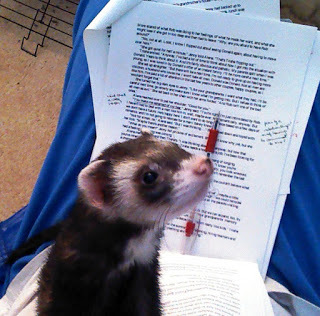 For writers, it’s important to find the right peer group for your needs. For many, this is a critique group. They may be large or small, meet in person or online, have open or closed membership, get together weekly or monthly or as needed. Finding a group that suits your needs is invaluable.
For writers, it’s important to find the right peer group for your needs. For many, this is a critique group. They may be large or small, meet in person or online, have open or closed membership, get together weekly or monthly or as needed. Finding a group that suits your needs is invaluable.Other writers share goals and deadlines, checking in with a friend daily or weekly to report progress. There’s that peer pressure again! Even a non-writing friend can help hold you accountable. (But choose carefully. Most people don't understand writing or the publishing business and have no idea how long it takes to get something published. Many people don't even realize that you may never sell a manuscript. You don't want someone making you feel bad because you haven't finished and sold your novel within six months.)
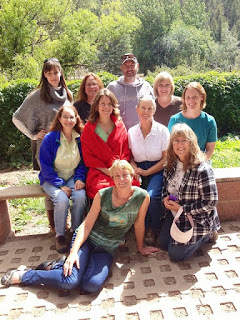 Finally, social groups can provide camaraderie and networking. I live in a small town with a science and engineering college; I know far more computer geeks than writers. But by making monthly trips to Albuquerque to attend a writing meeting, I’ve made many friends who understand what I do. I’ve also made connections by teaching workshops and guest speaking for groups like Sisters in Crime. For those who can’t attend in person, online discussion boards, listserves, and online classes offer information and a sense of connection.
Finally, social groups can provide camaraderie and networking. I live in a small town with a science and engineering college; I know far more computer geeks than writers. But by making monthly trips to Albuquerque to attend a writing meeting, I’ve made many friends who understand what I do. I’ve also made connections by teaching workshops and guest speaking for groups like Sisters in Crime. For those who can’t attend in person, online discussion boards, listserves, and online classes offer information and a sense of connection. It’s Distance, Not Speed
It really is about the journey, not how fast you get there. Pace yourself, and enjoy the journey, or you might burn out along the way. If you can see the end, or at least imagine the cheering crowds and free food, it might give you the extra boost you need to keep going. But take time to enjoy the sights, and the experience will be a lot more fun.
As a writer, don’t focus so much on the response to your query letters. Sure, celebrate successes, and try to learn from disappointments, but put most of your energy into enjoying the journey. (That works for the rest of life, too.)
Robin LaFevers had a post at Writer Unboxed about keeping creative play in your writing.
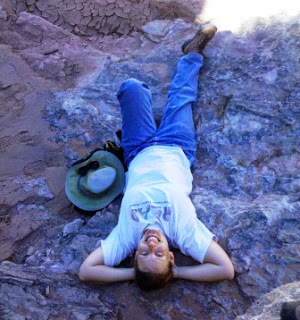 But Keep Moving
But Keep MovingA slow pace may get you there, but if you have a long way to go, you might as well do it running. A marathon will take a lot longer at a stroll than at a jog, even a slow jog. Run when you can, walk when you need a rest, but keep moving. That’s the only way to reach the end.
Take the time you need to learn and practice your writing craft. Do as many drafts as you need to polish your novel. Don’t rush, but do keep working. Write a page a day, and you’ll have a complete draft in a year. It may not be perfect, but it will be more than what you started with.
Practice Makes Perfect, or At Least Lessens the Pain
If you’re training, you need to get out regularly. Running once a month will just leave you sore and frustrated each time, and you won’t see any progress in your fitness.
It’s the same with writing. Establishing habits and sticking to them will keep your mind fit. Writing several times a week will hone your skills and make it easier to get started next time.
 Beware of Shortcuts
Beware of ShortcutsIf I map out a 5K run, but take every shortcut, that could cut the distance down to 3 1/2K. Easier, sure, but that won’t prepare me for running a 10K. It’s the same with life. Whether you’re trying to switch careers, meet the right man or woman, or finish a novel, some shortcuts may help, but others may do more harm than good.
I work with a lot of writing students. The beginners want to know if they’ll get published after taking one course. Nobody wants to spend 10 years learning how to write, but you need to do the work in order to earn the reward at the end. If you beg your friend to send your rough draft to her editor, you’ll blow your chance to make the best use of that connection. If you self publish your work before it’s ready, you’ll waste time that could be better spent working on your craft.
Sometimes the long, hard path is the only one that gets you where you want to go.
Push Yourself Sometimes
With enough practice, you should get better. When I started jogging, it was a struggle to go for 10 minutes without a break. Six months later, I could make it through 45 minutes without stopping.
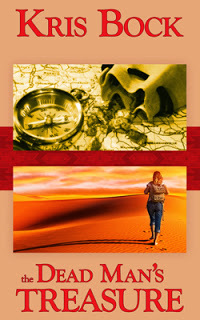 And then I plateaued. Jogging had become comfortable, if not easy. Why cause more pain by trying to go farther or faster?
And then I plateaued. Jogging had become comfortable, if not easy. Why cause more pain by trying to go farther or faster?Because that’s the only way to get better. And most likely, it’s the only way to stay interested. Fortunately, one of my jogging partners is great about coming up with new workouts. We add in some sprints one day, do hills another day. We choose different routes on different terrains. Variety keeps it interesting, which makes it easier to work hard.
With my writing, I find that I get bored if I become too comfortable with something. After publishing a dozen children’s books as Chris Eboch, I wanted a change. I began writing romantic suspense for adults, using the name Kris Bock. This brought new challenges – writing books two or three times as long as what I was used to, exploring romantic subplots, delving deeper into character. I didn’t always get things right the first time, but I became a better writer – and I renewed my interest in writing.
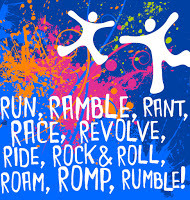 (Janice Hardy blogged about “growing pains” novels, the books we must struggle through in order to grow as writers.)
(Janice Hardy blogged about “growing pains” novels, the books we must struggle through in order to grow as writers.)Are you a writer who runs? Join the Writers Who Run Facebook Group to meet up with like-minded folks and learn about events.
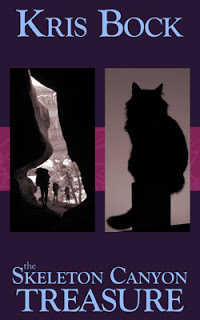 Kris Bock writes novels of suspense and romance with outdoor adventures and Southwestern landscapes. The Mad Monk’s Treasure follows the hunt for a long-lost treasure in the New Mexico desert. In The Dead Man’s Treasure, estranged relatives compete to reach a buried treasure by following a series of complex clues. In The Skeleton Canyon Treasure, sparks fly when reader favorites Camie and Tiger help a mysterious man track down his missing uncle.
Kris Bock writes novels of suspense and romance with outdoor adventures and Southwestern landscapes. The Mad Monk’s Treasure follows the hunt for a long-lost treasure in the New Mexico desert. In The Dead Man’s Treasure, estranged relatives compete to reach a buried treasure by following a series of complex clues. In The Skeleton Canyon Treasure, sparks fly when reader favorites Camie and Tiger help a mysterious man track down his missing uncle. Whispers in the Dark features archaeology and intrigue among ancient Southwest ruins. What We Found is a mystery with strong romantic elements about a young woman who finds a murder victim in the woods. In Counterfeits, stolen Rembrandt paintings bring danger to a small New Mexico town. Read excerpts at www.krisbock.com or visit her Amazon page.
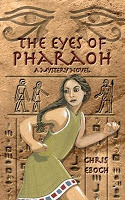 Chris Eboch writes fiction and nonfiction for all ages, with 40+ published books for children. Her novels for ages nine and up include Bandits Peak, a survival thriller that will appeal to fans of Gary Paulsen’s Hatchet; The Genie’s Gift, a fantasy adventure drawing on the Arabian Nights stories; The Eyes of Pharaoh, a mystery that brings ancient Egypt to life; The Well of Sacrifice, an action-packed drama set in ninth-century Mayan Guatemala; and the spooky-fun Haunted series, which starts with The Ghost on the Stairs.
Chris Eboch writes fiction and nonfiction for all ages, with 40+ published books for children. Her novels for ages nine and up include Bandits Peak, a survival thriller that will appeal to fans of Gary Paulsen’s Hatchet; The Genie’s Gift, a fantasy adventure drawing on the Arabian Nights stories; The Eyes of Pharaoh, a mystery that brings ancient Egypt to life; The Well of Sacrifice, an action-packed drama set in ninth-century Mayan Guatemala; and the spooky-fun Haunted series, which starts with The Ghost on the Stairs.  Chris's book Advanced Plotting helps writers fine-tune their plots, while You Can Write for Children: How to Write Great Stories, Articles, and Books for Kids and Teenagers offers great insight to beginning and intermediate writers. Learn more at www.chriseboch.com or her Amazon page, or check out her writing tips at her Write Like a Pro! blog.
Chris's book Advanced Plotting helps writers fine-tune their plots, while You Can Write for Children: How to Write Great Stories, Articles, and Books for Kids and Teenagers offers great insight to beginning and intermediate writers. Learn more at www.chriseboch.com or her Amazon page, or check out her writing tips at her Write Like a Pro! blog.
Published on September 27, 2017 04:00
July 8, 2017
Advanced Plotting Techniques With Chris Eboch from SCBWI 2017
 I'm giving a workshop on "Advanced Plotting Techniques" at the SCBWI conference in LA today. Here's the handout for attendees.
I'm giving a workshop on "Advanced Plotting Techniques" at the SCBWI conference in LA today. Here's the handout for attendees.Fast Start Options:Start in the action, at a moment of change. Then work in the back story.Start with two people on the page.Start with a scene, with action and dialogue. Use description and summary modestly, and only if really needed.Start in the middle of a fight or other conflict.Start with a cliffhanger – something powerful about to happen.The inciting incident – the problem that gets the story going – should happen as soon as possible, but not until the moment is ripe. The reader must have enough understanding of the character and situation to make the incident meaningful. Too soon, and the reader is confused. Too late, and the reader gets bored first.Try starting with a small problem that leads to the big problem, or is an example of the main problem.See also “Beginnings” Label below right
Plot Tricks:· Use the rule of three – the main character should try and fail at least twice before solving the problem on the third try. In long works, use this for each challenge.· Increase the complications – at each step, more is at stake, there’s greater risk. If each scene has the same level of risk and consequence, the pacing is flat and the middle sags. · Up the ante – offer a better reward or more serious consequences.· A time deadline increases tension.· Give it a twist – new information that changes everything but still makes sense (Darth Vader is Luke’s father).· If you get stuck on “What happens next?” try looking from the antagonist’s POV. What are they doing to stop your character? Other characters can also add complications.· Keep your chapters short, and make sure every one has dramatic action. · Use the Plot Outline Exercise from Advanced Plotting (Kindle on sale 50% off July 7-14)· More important and dramatic events should be written out in detail, others can be summarized. · Use shorter words and sentences to speed the pace.· See also “Plotting” Label below right.
· See also “Cliffhangers” Label below right
Story Analysis Resources:Self-Editing for Fiction Writers, by Renni Browne and Dave KingScene & Structure, Jack M. BickhamWriting the Blockbuster Novel, by Albert Zuckerman Advanced Plotting : a tool for analyzing your plot, articles on fast starts, developing middles, plot points, cliffhangers, and more advice on making your work stronger. The Plot Arc Exercise as a free Word downloadChris’s Write Like a Pro! blog has writing craft tips. Visit Blockbuster Plots for Writers for a test that shows whether your writing is more character driven or plot driven.Doug Eboch’s blog on Screenwriting uses movies for story analysisStrong starts, by Keith CroninPlot Maps by Lee Wardlaw, Project MayhemExample of plot mapping via Caroline Starr RoseThe Blake Snyder Beat Sheet Links to cool plot tools via Molly BlaisdellJanet Fox’s Diagram of Plot Points for different systemsDianne K. Salerni shares her plotting technique Beyond Story Mountains & Arcs: The Many Shapes of Stories, by Vicki Vinton shows how to analyze the stories of others. QueryTracker: How to Plot (or Revise) Your Book Annie Neugebauer's Novel Plotting Worksheet Jenny Meyerhoff's Plotting Worksheet

Chris Eboch’s book Advanced Plotting helps writers fine-tune their plots. Advanced Plotting is designed for the intermediate and advanced writer. If you struggle with plot or suspect your plotting needs work, this book can help. Use the Plot Outline Exercise to identify and fix plot weaknesses. Learn how to get off to a fast start, prop up a sagging middle, build to a climax, improve your pacing, and more.
Get Advanced Plotting from Amazon (Kindle on sale 50% off July 7-14).
Chris offers novel critiques for $2 per page ($100 minimum). Contact Chris for details and recommendations.
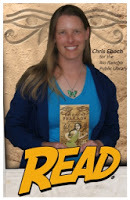 Chris Eboch is the author of over 40 books for children, including nonfiction and fiction, early reader through teen. Her novels for ages nine and up include The Eyes of Pharaoh, a mystery in ancient Egypt; The Well of Sacrifice, a Mayan adventure; The Genie’s Gift, a middle eastern fantasy; and the Haunted series, about kids who travel with a ghost hunter TV show, which starts with The Ghost on the Stairs. Her writing craft books include You Can Write for Children: How to Write Great Stories, Articles, and Books for Kids and Teenagers, and Advanced Plotting.
Chris Eboch is the author of over 40 books for children, including nonfiction and fiction, early reader through teen. Her novels for ages nine and up include The Eyes of Pharaoh, a mystery in ancient Egypt; The Well of Sacrifice, a Mayan adventure; The Genie’s Gift, a middle eastern fantasy; and the Haunted series, about kids who travel with a ghost hunter TV show, which starts with The Ghost on the Stairs. Her writing craft books include You Can Write for Children: How to Write Great Stories, Articles, and Books for Kids and Teenagers, and Advanced Plotting. Learn more at https://chriseboch.com/or her Amazon page.
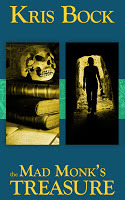 Chris also writes for adults under the name Kris Bock. Kris Bock writes action-packed romantic suspense involving outdoor adventures and Southwestern landscapes. The Mad Monk’s Treasure – free at all e-book retailers – follows a treasure hunt in New Mexico and has been called “Smart romance with an Indiana Jones feel.”
Chris also writes for adults under the name Kris Bock. Kris Bock writes action-packed romantic suspense involving outdoor adventures and Southwestern landscapes. The Mad Monk’s Treasure – free at all e-book retailers – follows a treasure hunt in New Mexico and has been called “Smart romance with an Indiana Jones feel.”Counterfeits starts a new series about art theft. What We Found is a mystery with romantic elements about a young woman who finds a murder victim in the woods. Whispers in the Dark involves intrigue among ancient Southwest ruins. Read excerpts at www.krisbock.com or visit her Amazon page
Published on July 08, 2017 05:00
July 7, 2017
Advanced Plotting Kindle #Sale - Improve Your Writing for Less Than $3
 “The Plot Outline Exercise is a great tool!”
“The Plot Outline Exercise is a great tool!” Advanced Plotting is 50% off for the Kindle – only $2.99 – from July 7-14.
Advanced Plotting is designed for the intermediate and advanced writer: you’ve finished a few manuscripts, read books and articles on writing, taken some classes, attended conferences. But you still struggle with plot, or suspect that your plotting needs work.
This book can help.
The Plot Outline Exercise is designed to help a writer work with a completed manuscript to identify and fix plot weaknesses. It can also be used to help flesh out an outline. Additional articles address specific plot challenges, such as getting off to a fast start, propping up a sagging middle, building to a climax, and improving your pacing. A dozen guest authors share advice from their own years of experience.
Read the book straight through, study the index to find help with your current problem, or dip in and out randomly — however you use this book, you’ll find fascinating insights and detailed tips to help you build a stronger plot and become a better writer.
Readers say:
This really is helping me a lot. It's written beautifully and to-the-point. The essays really help you zero in on your own problems in your manuscript. The Plot Outline Exercise is a great tool!
I just read and—dissected—your well written book: Advanced Plotting. It's now highlighted in bright orange and littered with many of those little 3M sticky labels. GOOD JOB. There are too many just-for-beginners books out there. Yours was a delight.
Advanced Plotting is helping me to be more focused, to stop and ask the right questions, to dig deeper.
Get it now at Amazon. Advanced Plotting is free with Kindle Unlimited, or pick up the paperback for $9.99 and add an e-book copy for only $.99.
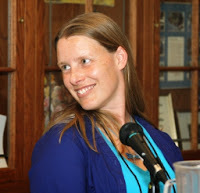 Chris Eboch is the author of over 40 books for children, including nonfiction and fiction, early reader through teen. Her novels for ages nine and up include The Eyes of Pharaoh, a mystery in ancient Egypt; The Well of Sacrifice, a Mayan adventure; The Genie’s Gift, a middle eastern fantasy; and the Haunted series, about kids who travel with a ghost hunter TV show, which starts with The Ghost on the Stairs. Her writing craft books include You Can Write for Children: How to Write Great Stories, Articles, and Books for Kids and Teenagers, and Advanced Plotting.
Chris Eboch is the author of over 40 books for children, including nonfiction and fiction, early reader through teen. Her novels for ages nine and up include The Eyes of Pharaoh, a mystery in ancient Egypt; The Well of Sacrifice, a Mayan adventure; The Genie’s Gift, a middle eastern fantasy; and the Haunted series, about kids who travel with a ghost hunter TV show, which starts with The Ghost on the Stairs. Her writing craft books include You Can Write for Children: How to Write Great Stories, Articles, and Books for Kids and Teenagers, and Advanced Plotting. Learn more at https://chriseboch.com/or her Amazon page.
Published on July 07, 2017 05:00
Earning a Living as a Writer, with Chris Eboch SCBWI 2017
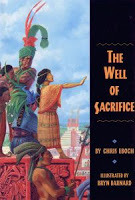
I'm giving a workshop on "Earning a Living As a Writer" at the SCBWI conference in LA today. Here's the handout for attendees.
Trade Book Advances: $2000-$30,000 and up. May take several years to receive all payments. Difficult to control or predict sales. Some small publishers do not pay advances.
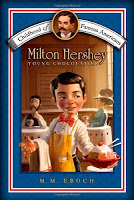 Royalties: Passive income that can last for years. Requires a royalty agreement that earns out. May take years after the book sale. Difficult to control or predict sales.
Royalties: Passive income that can last for years. Requires a royalty agreement that earns out. May take years after the book sale. Difficult to control or predict sales.Work-for-Hire Books: Flat fee (usually), quick turnaround time, assigned topics. Pays from a few hundred to several thousand dollars. Good for building a resume. Can be steady income.
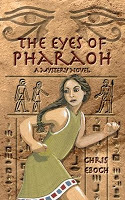 Self-Publishing: Upfront costs, especially with images. Potentially passive income for years. A way to make use of unsold manuscripts. Very tough market, especially for middle grade and younger. Create something unique and in demand. Know how you’ll reach readers.
Self-Publishing: Upfront costs, especially with images. Potentially passive income for years. A way to make use of unsold manuscripts. Very tough market, especially for middle grade and younger. Create something unique and in demand. Know how you’ll reach readers.Magazine Articles: Generally low pay for children’s magazines, but can be several hundred dollars. Make use of your research from other projects. Build a resume, show expertise.
Educational Test Passages/Assessment: Can be good pay for small jobs ($60-$400 for less than 1000 words). Requires ability to write a variety of genres, topics, and targeted grade levels. Mainly seasonal work. Those with teaching experience could write test questions.

Teaching: Community colleges, senior centers, summer programs, etc. Online: correspondence schools, webinars. One-on-one mentoring. Often low pay but builds resume/authority.
Critiques: Requires experience as an editor/teacher as well as a writer. Reputation counts. Pay can be $25-$50 an hour or more.
Copyediting/Proofreading: Requires specific expertise and training. Can be excellent money.
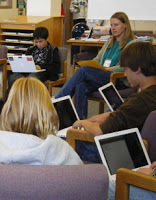 School Visits: Pay varies greatly. Helps market your books. If you’re not a well-known author, focus on what you’ll teach kids – help them do better on tests, foster love of reading, tie in to science or social studies curriculum.
School Visits: Pay varies greatly. Helps market your books. If you’re not a well-known author, focus on what you’ll teach kids – help them do better on tests, foster love of reading, tie in to science or social studies curriculum.General Info Making a Living from Writing? – Chris on sources of incomeLaura Purdie Salas shares her 2014 income and sources.The SCBWI discussion boardshave sections on work for hire, self-publishing, magazines, contracts, taxes, and moreUpod: “a place for freelancers to support, inspire, amuse, inform, advise, celebrate and hire each other.” (I have not tried it.)Kelly James-Enger “Dollars and Deadlines” blog on ghostwriting, articles, etc.The Well Fed Writer by Peter BowermanSecrets of a Freelance Writer by Bob Bly
Time management:Programs such as Slimtimer track your hours per project (I have not tried it.)
Work for Hire/Test Passages
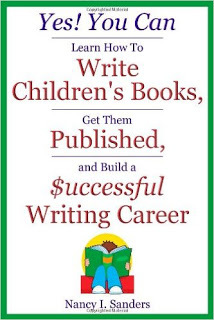 Yes! You Can Learn How to Write Children’s Books, Get Them Published, and Build a Successful Writing Career, by Nancy SandersWriting Children’s Nonfiction Books for the Educational Market, by Laura Purdie SalasEvelyn Christensen’s list of Educational MarketsWriting for the Education Market: job leads on WFH, inc test passagesPARCC Samples of test passages: under the Assessments tab, see "practice tests" and "released items" Get Curriculum Development Jobs: job postings in curriculum development
Yes! You Can Learn How to Write Children’s Books, Get Them Published, and Build a Successful Writing Career, by Nancy SandersWriting Children’s Nonfiction Books for the Educational Market, by Laura Purdie SalasEvelyn Christensen’s list of Educational MarketsWriting for the Education Market: job leads on WFH, inc test passagesPARCC Samples of test passages: under the Assessments tab, see "practice tests" and "released items" Get Curriculum Development Jobs: job postings in curriculum developmentEducation Writers Association has job listings, mainly full-time in-person
Linked In has a freelance job search site now.
Magazine Articles Magazine Markets for Children’s Writers, and Children’s Writers and Illustrator’s Market list possible magazines. The SCBWI “Magazine Market Guide” is in The Book, included with membership. Get magazine samples at your library, school, or house of worship; requests sample copies from the publisher; visit publishers’ web sites – many have online samples.List of Magazines for Children with links to the websites from the Monroe County Public Library
School VisitsSkype An Author Networkfor online visitsSchool Visit Experts: advice on programs and biz tips
 Chris Eboch is a popular writing teacher who gives workshops around the country. She writes fiction and nonfiction for all ages, with over 40 traditionally published books for children. Chris Eboch’s book Advanced Plotting helps writers fine-tune their plots. Advanced Plotting is designed for the intermediate and advanced writer. If you struggle
Chris Eboch is a popular writing teacher who gives workshops around the country. She writes fiction and nonfiction for all ages, with over 40 traditionally published books for children. Chris Eboch’s book Advanced Plotting helps writers fine-tune their plots. Advanced Plotting is designed for the intermediate and advanced writer. If you struggle  with plot or suspect your plotting needs work, this book can help. Use the Plot Outline Exercise to identify and fix plot weaknesses. Learn how to get off to a fast start, prop up a sagging middle, build to a climax, improve your pacing, and more.
with plot or suspect your plotting needs work, this book can help. Use the Plot Outline Exercise to identify and fix plot weaknesses. Learn how to get off to a fast start, prop up a sagging middle, build to a climax, improve your pacing, and more. Get Advanced Plotting from Amazon (Kindle on sale 50% off July 7-14).
Chris offers novel critiques for $2 per page ($100 minimum). Contact Chris for details and recommendations.
 Chris’s novels for ages nine and up include The Eyes of Pharaoh, a mystery in ancient Egypt; The Well of Sacrifice, a Mayan adventure; The Genie’s Gift, a middle eastern fantasy; and the Haunted series, about kids who travel with a ghost hunter TV show, which starts with The Ghost on the Stairs. Her writing craft books include You Can Write for Children: How to Write Great Stories, Articles, and Books for Kids and Teenagers, and Advanced Plotting.
Chris’s novels for ages nine and up include The Eyes of Pharaoh, a mystery in ancient Egypt; The Well of Sacrifice, a Mayan adventure; The Genie’s Gift, a middle eastern fantasy; and the Haunted series, about kids who travel with a ghost hunter TV show, which starts with The Ghost on the Stairs. Her writing craft books include You Can Write for Children: How to Write Great Stories, Articles, and Books for Kids and Teenagers, and Advanced Plotting. Learn more at https://chriseboch.com/or her Amazon page.
 Chris also writes for adults under the name Kris Bock. Kris Bock writes action-packed romantic suspense involving outdoor adventures and Southwestern landscapes. The Mad Monk’s Treasure – free at all e-book retailers – follows a treasure hunt in New Mexico and has been called “Smart romance with an Indiana Jones feel.”
Chris also writes for adults under the name Kris Bock. Kris Bock writes action-packed romantic suspense involving outdoor adventures and Southwestern landscapes. The Mad Monk’s Treasure – free at all e-book retailers – follows a treasure hunt in New Mexico and has been called “Smart romance with an Indiana Jones feel.”
Counterfeitsstarts a new series about art theft. What We Found is a mystery with romantic elements about a young woman who finds a murder victim in the woods. Whispers in the Dark involves intrigue among ancient Southwest ruins. Read excerpts at www.krisbock.com or visit her Amazon page.
Published on July 07, 2017 05:00



